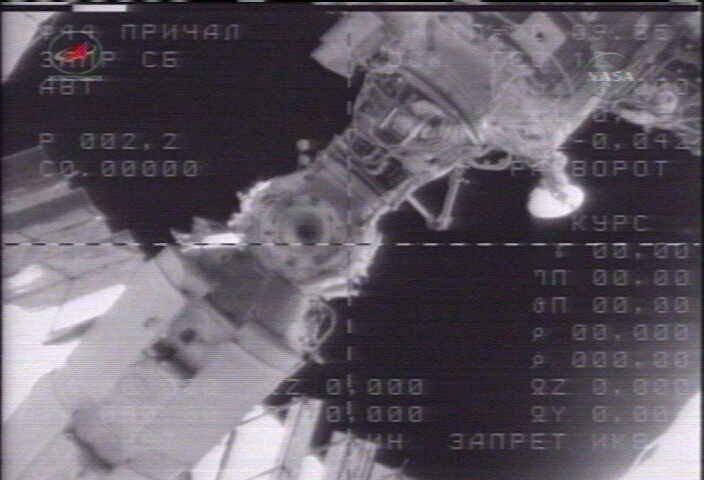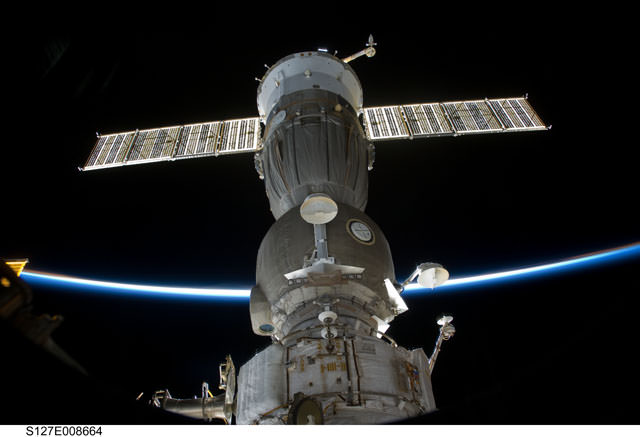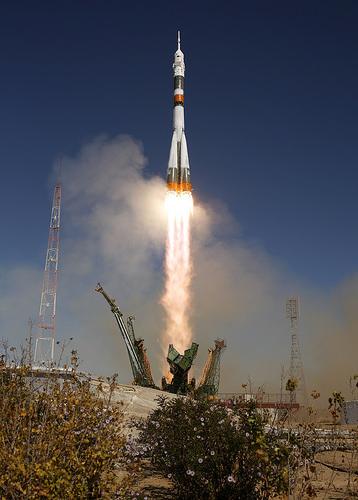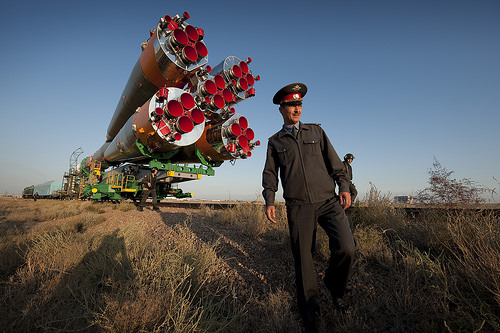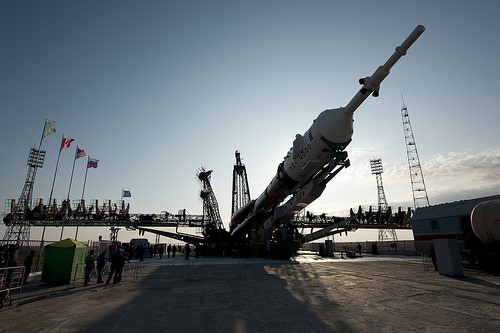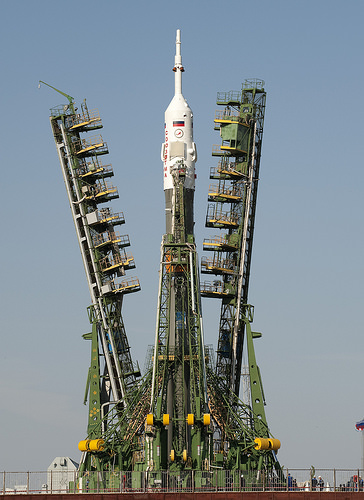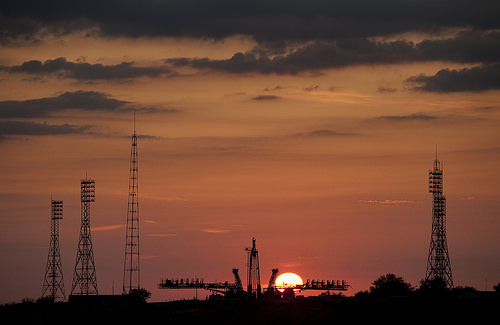Following today’s departure of the three man crew of Expedition 21 aboard the Soyuz TMA 15 capsule, staffing on the International Space Station (ISS) is now temporarily reduced to a skeleton crew of just 2 men for the first time since July 2006. The ISS had hosted a complete 6 person and truly international crew complement for the first time ever since its inception, starting in May of this year.
Soyuz Commander Roman Romanenko (Russia), European Space Agency Flight Engineer Frank De Winne (Belgium) and Canadian Space Agency Flight Engineer Bob Thirsk floated into their three segment Soyuz return capsule on Monday evening, Nov 30. After powering up systems and a farewell ceremony the hatches were closed at 7:43 PM EST. They disengaged hooks and latches and then physically undocked from the Zarya module at 10:56 PM over Mongolia after spending 188 days in space. De Winne was the first European commander of the ISS. All prior commanders have been either Russian or American. Romanenko is a second generation cosmonaut. His father Yuri, flew his first mission in 1980. Thirsk is the first long duration Canadian astronaut.
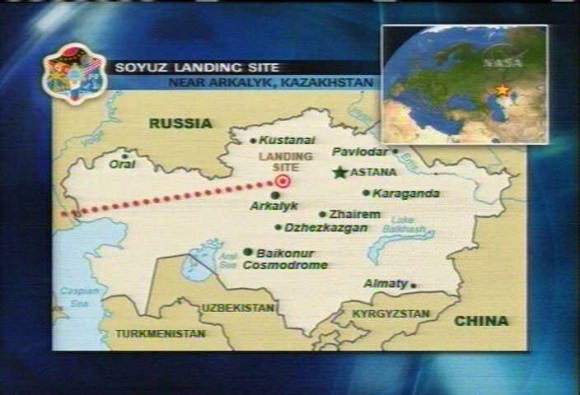
Retro rockets were fired for 4 min 19 sec at 1:26 AM Tuesday morning to initiate the de-orbit braking maneuver for the fiery plunge of atmospheric reentry. 19 minutes later the three Soyuz segments pyrotechnically separated at an altitude of 87 miles. The Soyuz barreled backwards as it hit the earth’s atmosphere at 400,000 ft above Africa and the crew experienced maximum G forces. The three parachuted to a safe touchdown strapped inside their Soyuz descent module onto the snowy steppes of Kazakhstan at 2:15 AM Tuesday Dec 1 (1:15 PM Kazakhstan local time) thereby concluding a mission that began with a May 27 blast off. Russian search and recovery forces drove to the ice cold landing zone at Arkalyk to greet and assist the trio in opening the hatch, exiting the craft, readapting to earth’s gravity and returning to Star City. This was the first December landing of a Soyuz since 1990.
Poor icy weather and low clouds grounded the normal recovery force of 8 helicopters. The capsule landed right on target and in an upright configuration. Recovery forces sped quickly into place. Romanenko was first to depart out the top hatch of the capsule, followed by Thirsk and De Winne. They were carefully extracted by the ground based recovery team and immediately assisted into stretchers while smiling broadly and waving to the crowd. Then they were swiftly slid into all terrain vehicles larger than their capsule for the initial leg of the ride back to Russia. Flight surgeons confirmed the health of the crew who are eager to re-unite with family and friends and earthly comforts.
The Expedition 22 core crew of NASA Commander Jeff Williams and Russian Flight Engineer Max Suraev remain as the sole two occupants for about three weeks until the Dec 23 arrival of the next international crew comprising Russian cosmonaut Oleg Kotov, NASA’s T.J. Creamer, and Soichi Noguchi of the Japan Aerospace Exploration Agency who head to the station Dec. 20 on the Soyuz TMA-17 craft from the Baikonur Cosmodrome. Williams and Suraev arrived by Soyuz capsule TMA -16 in October.
US astronaut Nicolle Stott rounded out the six person ISS crew until her departure just days ago on Nov 25 aboard shuttle Atlantis (link) left just five people on board. She spent 91 days aloft conducting science experiments and has the distinction of being the last ISS resident to hitch a ride up and down on a shuttle. Future crew rotations are planned via Russian Soyuz rockets since the shuttle will be retired by late 2010 and NASA’s Ares / Orion launch system won’t debut until 2015 or later.
Watch video of the shuttle “belly flip” as it arrives at the station.
During 7 days of joint operations in late November, the ISS boasted an ethnically diverse population of 12 humans from the combined crews of STS 129 Atlantis and the resident ISS members from two docked Soyuz capsules, just shy of the record 13 occupants. With all the comings and goings of assorted manned and robotic spaceships lately it’s been an exceptionally busy time that required careful planning and traffic coordination among the world’s space agencies.
The 800,000 pound station is now 86% complete and thus far larger and more complex compared to the last instance of a two person contingent. Since the 2005 Return to Flight of the shuttle following the Columbia accident, several habitable modules (Harmony, Columbus, Kibo, Poisk), truss segments, radiators, stowage platforms and giant solar arrays have been attached. All this has vastly expanded the astronauts and cosmonauts daily responsibilities of both maintaining station systems and carrying out a much expanded scientific research program.
Bill Gerstenmaier, NASA’s chief of space operations, said the ISS partners have carefully looked at the operational challenges of this three week interlude to make sure “there is not a lot of activity going on then, other than some software uploads. We moved all the major activities that were occurring to other periods when there will be more crew. We are prepared and ready to cut back a little on operations but still be able to do a little bit of science research with just two crew members on orbit.”
Three space walks by the Atlantis crew helped pave the way for the next shuttle ISS assembly flight in February 2010, designated STS 130, which will haul up the long awaited Tranquility and Cupola modules and which I recently observed close up at the ESA to NASA hand off ceremony inside the Space Station Processing Facility (link) (SSPF) at the Kennedy Space Center.
Atlantis delivered two large pallets loaded with 15 tons of critical spare parts that will help extend the working lifetime of the ISS and serve as a hedge against on orbit equipment failures ahead of the fast approaching deadline when the space shuttle is no longer available to loft such bulky gear.
Only 5 flights remain until the shuttle era ends late in 2010. The Orion capsule will not debut for at least five years and perhaps longer, dependent on funding decisions in Washington, DC. The station will then be completely dependent for supplies and equipment on Russian, European and Japanese cargo vehicles. Test flights of US commercial ISS transport vessels begin next year.
Not until another three person Soyuz blasts off next April 2010, will the station return to a full team of six. But science research will be full speed ahead.

